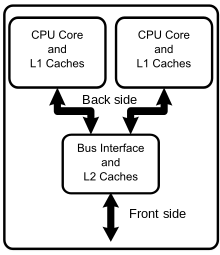
Back معالج متعدد النوى Arabic Многоядрен процесор Bulgarian Processador Multinucli Catalan Vícejádrový procesor Czech Flerkernet processor Danish Mehrkernprozessor German Procesador multinúcleo Spanish Mitmetuumaline protsessor Estonian پردازنده چندهستهای Persian Moniytimellisyys (tietotekniikka) Finnish



A multi-core processor (MCP) is a microprocessor on a single integrated circuit (IC) with two or more separate central processing units (CPUs), called cores to emphasize their multiplicity (for example, dual-core or quad-core). Each core reads and executes program instructions,[1] specifically ordinary CPU instructions (such as add, move data, and branch). However, the MCP can run instructions on separate cores at the same time, increasing overall speed for programs that support multithreading or other parallel computing techniques.[2] Manufacturers typically integrate the cores onto a single IC die, known as a chip multiprocessor (CMP), or onto multiple dies in a single chip package. As of 2024, the microprocessors used in almost all new personal computers are multi-core.
A multi-core processor implements multiprocessing in a single physical package. Designers may couple cores in a multi-core device tightly or loosely. For example, cores may or may not share caches, and they may implement message passing or shared-memory inter-core communication methods. Common network topologies used to interconnect cores include bus, ring, two-dimensional mesh, and crossbar. Homogeneous multi-core systems include only identical cores; heterogeneous multi-core systems have cores that are not identical (e.g. big.LITTLE have heterogeneous cores that share the same instruction set, while AMD Accelerated Processing Units have cores that do not share the same instruction set). Just as with single-processor systems, cores in multi-core systems may implement architectures such as VLIW, superscalar, vector, or multithreading.
Multi-core processors are widely used across many application domains, including general-purpose, embedded, network, digital signal processing (DSP), and graphics (GPU). Core count goes up to even dozens, and for specialized chips over 10,000,[3] and in supercomputers (i.e. clusters of chips) the count can go over 10 million (and in one case up to 20 million processing elements total in addition to host processors).[4]
The improvement in performance gained by the use of a multi-core processor depends very much on the software algorithms used and their implementation. In particular, possible gains are limited by the fraction of the software that can run in parallel simultaneously on multiple cores; this effect is described by Amdahl's law. In the best case, so-called embarrassingly parallel problems may realize speedup factors near the number of cores, or even more if the problem is split up enough to fit within each core's cache(s), avoiding use of much slower main-system memory. Most applications, however, are not accelerated as much unless programmers invest effort in refactoring.[5]
The parallelization of software is a significant ongoing topic of research. Cointegration of multiprocessor applications provides flexibility in network architecture design. Adaptability within parallel models is an additional feature of systems utilizing these protocols.[6]
In the consumer market, dual-core processors (that is, microprocessors with two units) started becoming commonplace on personal computers in the late 2000s.[7] Quad-core processors were also being adopted in that era for higher-end systems before becoming standard. In the late 2010s, hexa-core (six cores) started entering the mainstream[8] and since the early 2020s has overtaken quad-core in many spaces.[9]
- ^ Rouse, Margaret (March 27, 2007). "Definition: multi-core processor". TechTarget. Archived from the original on August 5, 2010. Retrieved March 6, 2013.
- ^ Schauer, Bryan. "Multicore Processors – A Necessity" (PDF). Archived from the original (PDF) on 2011-11-25.
- ^ Cite error: The named reference
10496 CUDA coreswas invoked but never defined (see the help page). - ^ "Sunway TaihuLight - Sunway MPP, Sunway SW26010 260C 1.45GHz, Sunway | TOP500". www.top500.org. Retrieved 2020-09-15.
- ^ Suleman, Aater (May 20, 2011). "What makes parallel programming hard?". FutureChips. Archived from the original on May 29, 2011. Retrieved March 6, 2013.
- ^ Duran, A (2011). "Ompss: a proposal for programming heterogeneous multi-core architectures". Parallel Processing Letters. 21 (2): 173–193. doi:10.1142/S0129626411000151.
- ^ "Definition of dual core". PCMAG. Retrieved 2023-10-27.
- ^ "Intel taking its six-core processors mainstream in 2018 with Coffee Lake family". ZDNET. Retrieved 2023-10-27.
- ^ Alan Dexter (2022-04-05). "Six-core CPUs are now more popular than quad-core chips on Steam". PC Gamer. Retrieved 2024-05-22.